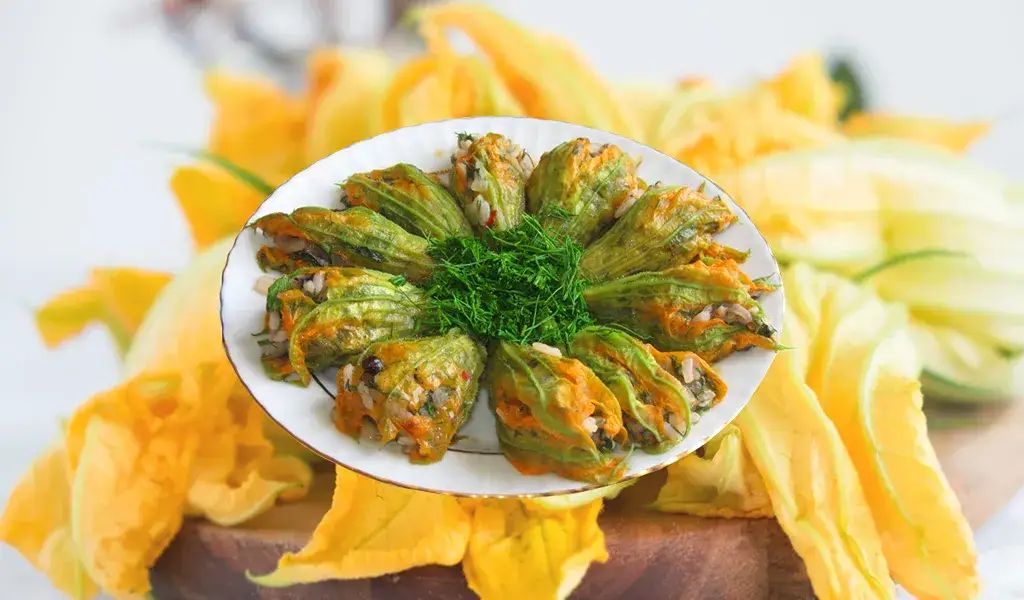
The Most Famous Dishes of the Aegean
When we think of the Aegean, a picture immediately comes to mind. The deep blue sea, hills covered with olive trees, villages with stone streets, and the delicious smell of olive oil rising from the tables. This region draws people in not only with its nature but also with its cuisine. Aegean cuisine is as healthy and light as it is delicious. The food in these lands is not ostentatious but sincere, just like the people. Even the simplest herb, picked at the right time and combined with a little olive oil and lemon, becomes the most talked-about delicacy on the table. Zucchini flowers are picked early in the morning, before the sun is fully up, so they don't wilt. Artichokes are prepared with such care that they arrive on the plate like flowers. Whatever comes from the sea, whatever is available that day, is cooked fresh. No excessive spices or heavy sauces. Everything is served as nature intended, without exaggeration, just as it is. Aegean tables are laden with greens, olive oil-based vegetables, seasonal herbs, and seafood. Delicacies like fava beans, broad beans, purslane, and artichokes are not just food. Each one is like a memory. The olive oil dishes your grandmother made at the summer house, that last bite left on the plate from the neighbor's dish, are like pieces carried from the past to the present. When you sit down at the table in the Aegean, you don't just eat; you chat, you laugh, and sometimes even the silence is meaningful. Those moments somehow get etched into your memory. Every part of Turkey is full of flavor, but there's something else in the Aegean cuisine. Maybe it's a little simpler, but that's exactly why it's more authentic.
Famous Dishes of the Aegean Region
- Stuffed Squash Blossoms
- Broad Beans
- Olive Oil Stuffed Grape Leaves
- Stuffed Artichokes
- Şevketi Bostan
- Şambali
- Papaz Yahnisi
- Labada Salad
- Fava
- Herb Pie
- Aegean Keşkeği
- Olive Oil Bakla
Stuffed Zucchini Blossoms
One of the most special flavors of Aegean cuisine is without a doubt stuffed zucchini blossoms. These delicate flowers are carefully picked at dawn, before the sun rises. Their centers are filled with a stuffing—sometimes with minced meat, sometimes vegetarian with olive oil and herbs. If your journey takes you to the Aegean, this is a must-try dish, as it’s rarely found elsewhere. Both in looks and taste, stuffed zucchini blossoms capture hearts and always hold a top spot in Aegean gastronomy. From May until the end of October, they are prepared with great care due to their fragile structure and find their place on seasonal tables. You can taste the best ones in popular Aegean towns such as Cunda, Alaçatı, Çeşme, Bodrum, and İzmir. This dish is one of the finest reflections of the Aegean’s natural and heartfelt food culture.

Samphire (Sea Beans)
Among the unforgettable flavors of the Aegean coast is samphire, or sea beans. Growing naturally in salty coastal soils, it is boiled, then dressed simply with olive oil and lemon, and served cold. Some add garlic, which gives it a slightly sharp, distinct taste. Though it may look like just a meze, sea beans are essential at summer dinners, especially on a meze platter alongside rakı and olive oil-based dishes. In the Aegean, particularly at seafood restaurants, it’s nearly impossible not to encounter this dish. For the freshest experience, try preparing it at home—boiled right after being picked and dressed with lemon and olive oil. That’s when its flavor shines brightest, perfectly embodying the Aegean’s simplicity and naturalness on a plate.

Stuffed Artichokes
Among the elegant and delicate Aegean flavors is stuffed artichokes. With their spring-like appearance, they win hearts both with taste and presentation. Fresh, whole artichokes are filled with a light olive-oil-based stuffing rich in herbs. Dill, green onions, rice, lemon, and olive oil come together to create a dish that is gentle yet unforgettable. The stuffed artichokes are simmered slowly in lemony, slightly sweetened water—never rushed. Even the aroma that fills the kitchen as they cook is enough to whet the appetite. The first bite reveals a perfect harmony between the tender artichoke and its stuffing. Try one in Cunda or in an old restaurant tucked away in İzmir’s streets, and the memory of its flavor will linger for years.

Şevketi Bostan
A unique herb rarely seen outside Aegean villages, şevketi bostan is a true local treasure. Cleaning its thorny leaves takes effort, but one taste proves it’s worth it. Harvested from late autumn until spring, it requires patience to prepare. Once cooked often with lamb it becomes the star of the table. Sautéed with onions and garlic, served with a lemony or flour-based sauce, or even as a simple olive oil dish, it always carries its distinctive flavor. Some prepare it as a salad, others lightly boil and dress it with lemon. However it’s made, it is unmistakable. The best şevketi bostan can be found in Urla’s old taverns, Tire’s villages, Seferihisar’s vineyards, or Foça by the sea.

Şambali
Walking through İzmir’s streets, you’ll often be drawn by the aroma of şambali, a beloved dessert. Made from semolina, yogurt, flour, and eggs, the thick mixture is spread in a tray, topped with almonds, and baked until golden. Once out of the oven, hot syrup is poured over it, slowly absorbed. The result is neither overly sweet nor too dry, but perfectly balanced with a rich texture. Known also as “Şambaba” in some regions, şambali is firm on the outside, soft inside, and irresistibly moreish. Each bite recalls the warmth of homemade desserts, with its syrupy richness and almond topping giving it both flavor and elegance.

Papaz Yahnisi
One of the lesser-known yet unforgettable Aegean dishes is Papaz Yahnisi. With the first bite, it settles into your heart without warning. Made with beef, pearl onions, and garlic, it cooks slowly, developing a slightly sweet and perfectly balanced flavor. Said to be beloved by Greek priests in the past, this dish has roots in Ottoman cuisine and still graces Aegean tables today. Some chefs seal the pot with dough to keep all the flavors inside—a method that fills the house with the warm aroma of cooking. Tender meat blending with the onions results in a dish that looks simple on the plate but carries a rich story. Papaz Yahnisi may not be served daily, but when it appears, it’s savored slowly and appreciatively.

Dock Salad (Labada)
Labada is one of the fresh, healthful greens of the Aegean table. Rich in vitamin C and known for boosting immunity, it appears often in spring meals. İzmir kitchens are particularly fond of Labada Salad, a light, energizing dish that’s as nutritious as it is refreshing. With its natural, vibrant taste, it appeals to both food lovers and health-conscious eaters alike.

Fava
Made from dried broad beans, fava is a signature Aegean meze, though achieving the right creamy consistency takes skill. Olive oil’s smoothness, the subtle taste of beans, and the freshness of dill sprinkled on top combine into a dish that pleases both the palate and the eye. Fava is not only enjoyed as a meze but also as a filling for pastries and canapés. For the best fava, head to Ayvalık, Cunda, Kuşadası, or İzmir’s seafood restaurants, where it’s prepared with fresh ingredients and local expertise. Fava isn’t just food it’s a story of the Aegean’s fertile lands, crafted with care and tradition.

Herb Börek
Herb börek is a savory pastry filled with a mix of fresh Aegean greens like spinach, chard, mallow, and sorrel, combined with curd cheese. Its real charm lies in the skillful hands of Aegean cooks who make it with love. From Alaçatı’s breezy streets to Sığacık’s calm shores, from Bademli’s village homes to Şirince’s narrow stone lanes you’ll find some of the best herb böreks in these places.

Aegean Keşkek
Keşkek is a traditional dish found across Anatolia, but it has a special place in Aegean cuisine. Made with tender meat, bone broth, and cracked wheat, it is both filling and soulful. In the Aegean, you’ll often find it in restaurants that emphasize traditional flavors. More than a dish, keşkek symbolizes friendship and sharing, with each spoonful warming both body and spirit.

Fresh Broad Beans in Olive Oil
Fresh broad beans cooked in olive oil are a staple of spring tables in the Aegean. Served cool, often with yogurt, the dish is finished with plenty of fresh dill. Each spoonful reflects the freshness of spring and the warmth of nature. Simple, yet deeply comforting, broad beans in olive oil capture the essence of the Aegean in every bite.

Beyond these, Aegean cuisine offers endless discoveries. From seafood and milk-based desserts to regional fruits, jams, and cheeses, every bite reflects the region’s richness. Local dairies, fresh herbs from the fields, and sweet grapes from vineyards all contribute to the authenticity of Aegean flavors. Markets, olive oil mills, and spice gardens offer a deeper understanding of this food culture.
Aegean cuisine is not just about food it’s a way of life intertwined with nature, people, and tradition. The more you taste and learn, the more you connect with the soul of this unique region.
Exploring local farmers’ markets is one of the best ways to discover the Aegean’s fresh ingredients. To learn more, check out our guide: “Aegean Farmers’ Markets: Where and When Are They Held?”































